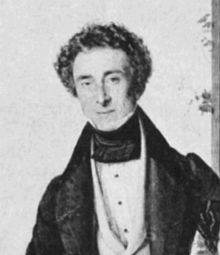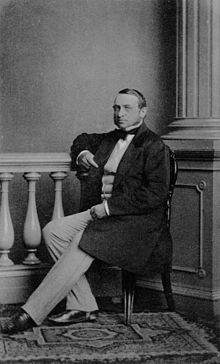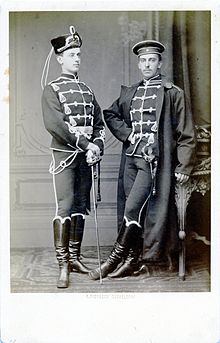HJ Merck & Co.
| HJ Merck & Co. | |
|---|---|
| legal form | Open trading company |
| founding | 1799 |
| resolution | 1983 |
| Seat | Hamburg, Germany |
| Branch | trade |
HJ Merck & Co. was a trading company founded in 1799 , which later became one of the largest Hamburg merchant bankers of its time and existed until 1983. In addition to trading and banking activities, a shipping company was also initially operated. As an important investor, the company played a leading role in the founding of Hapag and the Norddeutsche Bank . Later on, H. J. Merck & Co. were heavily involved in the fertilizer business.
founding
After an apprenticeship in Strasbourg , Heinrich Johann Merck came to Hamburg in 1794 and became an employee of the Hamburg company Sel. Paul Danckert Wwe et Comp. This company dealt with imports, exports and calico printing , Merck represented the company at the Leipziger Messe . There he recognized the demand for yarn from the developing Vogtland cloth making (→ Plauener Spitze ). In 1799 Merck acquired Hamburg citizenship and founded the company HJ Merck, which dealt with the sale of industrially manufactured English cotton yarns, known as Twist . The economically difficult period for Hamburg during the French period from 1806 to 1814, when goods traffic on the Elbe almost came to a standstill due to the continental blockade, was bridged by Merck by participating in the lucrative smuggling of English goods. In 1810, Merck bought part of the Mortzenhaus on the old wall frame in order to house his company's warehouse and office. The other part of the Mortzenhaus was where the company Joh.Berenberg, Gossler & Co. was located; the neighboring house was the headquarters of JC Godeffroy & Sohn , and later it was there also set up the Godeffroy Museum .
Consolidation
In 1815 the company name was changed to HJ Merck & Co. when Florentin Theodor Schmidt and Johannes Christian Dürbig became partners. Dürbig represented the Merck branch set up in Leipzig , Dürbig & Co. In 1817 another subsidiary was founded in Manchester , which was responsible for purchasing yarn on the English market. HJ Merck & Co. mainly imported English yarns, but was also busy with Silesian zinc , Eastern European grain and , from the 1920s, with the import of raw cotton . Increasingly, however, banking transactions were also carried out, i. H. Issuing loans and trading bonds . Since business was going very well, further partners were accepted, in 1831 his son Heinrich Johann Merck jr. (1804–1835), in 1836 his son-in-law Justus Ruperti (full name: Justus Carl Wilhelm Ruperti ) for the late Johannes Christian Dürbig, in 1840 his son Ernst Merck . Later his son Theodor Merck (1816-1889) and a son of Florentin Theodor Schmidt were added. Heinrich Johann Merck senior died on October 23, 1853. and Ernst Merck and Justus Ruperti continued the Hamburg business. Theodor Merck managed the branch in Manchester until 1860 and then returned to the head office in Hamburg.
In 1831 the total capital of the company was 1,632,000 marks Banco .
By the mid-twenties, HJ Merck & Co. owned up to 6 ships of their own, which were then sold one after the other. In 1846, HJ Merck & Co. played a leading role in founding Hapag.
The 1850s
From 1853 onwards, HJ Merck & Co. managed to revive the cotton business that had been idle in the previous years and to build up an important cotton trade with Russia through several business trips to Russia . Due to the large number of spinning mills that arose there, there was a great demand for raw cotton, which was largely satisfied by HJ Merck & Co. In addition to share issues such as the Austrian Railway Shares, the company was heavily involved in trading with Sweden. In 1856 the two partners Schmidt left and were paid out.
Foundation of the Norddeutsche Bank
A founding consortium with the participation of HJ Merck & Co. had already met in 1845 with the intention of founding their own bank based on the Hanseatic cities of Lübeck and Bremen. At that time the council had refused the request. A new consortium met in 1854 and drafted statutes for a private central bank , which should also have the right to issue banknotes in its own name. After lengthy negotiations, the documents were submitted to the council on May 21, 1856. Another group of merchants managed to found the Vereinsbank in Hamburg at the end of July 1856 . Thereupon the consortium moved away from the claim to its own banknote issue and with changed documents on August 15, 1856 the establishment of the North German Bank was allowed.
Trade Crisis 1857
The panic of 1857 survived HJ Merck & Co. with some effort. HJ Merck & Co. were not badly affected by the crisis until November 1857; they too had given too generous credit and their borrowers stopped making payments. The rescue measures of the Hamburger Rath proved to be decisive for survival . This provided HJ Merck & Co. with 5 million Mark Banco half of a silver loan borrowed from Vienna. Equity fell in the crisis from 5.1 million Mark Banko to 3.7 million Mark Banko. The Manchester branch of HJ Merck & Co. was liquidated during the crisis. Around 1860, profits from banking and trading were roughly the same in the profit statement.
In 1860 Oscar Ruperti (1836–1924) joined the company and after the death of his father Justus Ruperti († 1861) and Ernst Mercks († 1863) became head of the company.
In the years from 1865 onwards, the cotton business was slowly abandoned and, instead, the guano trade in particular expanded; investments were successively made in production plants in Chile and Spain and our own processing plants were also set up. As the climax of this development, Oscar Ruperti spun off the guano business from HJ Merck & Co. at the turn of the century and founded Merckschen Guano & Phosphatwerke AG
HJ Merck & Co. continued to trade in goods and banking, albeit not as spectacularly as before. In 1885, HJ Merck & Co. was involved in the issue of the shares of the Hamburger Freihafen-Lagerhaus-Gesellschaft .
Partner
In later years, other male descendants join the company as partners, such as Ernst Merck's son, Baron Carl Heinrich von Merck.
Ernest William Merck (born June 5, 1854 in Manchester † October 9, 1939 in Hamburg ), son of Theodor Merck, joined HJ Merck & Co. at the end of 1880 at the age of 26. He was comprehensively prepared for his job. First he completed a 3-year commercial apprenticeship in the company Rimpau & Co. in Hamburg. After a year as a one-year volunteer with the 2nd Westphalian Hussar Regiment No. 11 in Düsseldorf , Ernest William Merck worked in London from 1876 to 1879 in various companies in the banking, coffee and sugar trade. He then worked in North America and Bordeaux for 6 months each . In 1883 he obtained power of attorney and in 1890 became a partner at HJ Merck & Co. He was a partner until at least 1929 and was also a member of the supervisory boards of Guanowerke AG and Norddeutsche Bank AG.
Erwin Johannes Merck (* 1900; † 1947), son of Ernest William Merck, became a partner after the First World War.
Later years
After the First World War , it was mainly the goods business, the banking business played a subordinate role since then. In November 1932 Erwin Merck was one of the signatories of the industrialists ' petition calling on President Paul von Hindenburg to appoint Adolf Hitler as Reich Chancellor. Later the banking business was intensified again, especially in the securities business, and the company came under the influence of Bank Mees & Hope NV, which held almost 100% of H. J. Merck & Co. Mees & Hope NV, a long-established Dutch banking house, was bought by Algemene Bank Nederland in 1975 . The two personally liable partners Werner Töben and Eberhard Plassmann managed the banking business until January 1, 1984 in spatial and personal union with the Hamburg branch of Mees & Hope. The balance sheet total was only about 12 million marks at the end, since the business was gradually taken over by Mees & Hope.
Others
- The company of the same name that exists today is a start-up and agency for electrical machines and pumps.
- The family crypt of the Heinrich Johann Merck family is located on the site of today 's Jacobipark , the former cemetery of the main church of St. Jacobi . Are buried here u. a. Heinrich Johann Merck (1770-1853), Heinrich Johann Merck jr. (1804–1835), Ernst (Freiherr von) Merck (1811–1863) and Theodor Merck (1816–1889). Exactly opposite is the grave of Justus Carl Wilhelm Ruperti (1791–1861). Both grave sites are among the few that remain on the park area today.
- The later partner Ernest William Merck and his son Erwin Johannes Merck are buried in the old Niendorf cemetery . The grave is located in the immediate vicinity of the Heymann mausoleum and is adorned with a bronze grave plate.
literature
- Percy Ernst Schramm : Hamburg, Germany and the World; Achievements and limits of the Hanseatic bourgeoisie in the period between Napoleon and Bismarck ; Hamburg, 2nd edition, 1952
Individual evidence
- ^ Schramm: Hamburg ... p. 96
- ↑ a b c Family crypt of the Heinrich Johann Merck family and the tombstone of Justus Carl Wilhelm Ruperti in today's Jacobi-Park, the former cemetery of the main church St. Jacobi.
- ^ Schramm: Hamburg ... p. 363
- ^ Schramm: Hamburg ... p. 361
- ↑ a b Schramm: Hamburg ... p. 378
- ^ Schramm: Hamburg ... p. 386
- ^ Schramm: Hamburg ... p. 421
- ↑ Helmut Böhme: economic crisis, merchant bankers and constitutional reform in journal for Hamburg history, volume 54, 1968, p. 102 f
- ^ Schramm: Hamburg ... p. 112
- ↑ see article about Ruperti in Hamburger Nachrichten No. 290 of July 24, 1921
- ↑ Helmut Böhme: Economic Crisis, Merchant Bankers and Constitutional Reform in Journal for Hamburg History, Volume 54, 1968, p. 103
- ↑ The following partners were mentioned: Carl Heinrich Johann von Merck (1843–1920); Theodor Merck; Oscar Rupperti and Alexander Borgnis (1827–1914). From: Frank M. Hintz: Planning and Financing of the Speicherstadt in Hamburg, mixed-economy company foundations in the 19th century with special consideration of the Hamburg Freihafen-Lagerhaus-Gesellschaft, publication of the Hamburg Working Group for Regional History (HAR) Vol. 7, 2000, footnote 675, P. 195
- ↑ Surname: Merck on TribalPages , accessed October 18, 2012
- ^ Georg Wenzel: German business leader . Life courses of German business personalities. A reference book on 13,000 business figures of our time. Hanseatische Verlagsanstalt, Hamburg / Berlin / Leipzig 1929, DNB 948663294 , p. 1470.
- ↑ on this German Gender Book, Volume 18, 1910
- ↑ Merck Bank transfers business to Mees & Hope ( Memento of the original from April 8, 2014 in the Internet Archive ) Info: The archive link was automatically inserted and has not yet been checked. Please check the original and archive link according to the instructions and then remove this notice. , in: Hamburger Abendblatt , November 30, 1983







